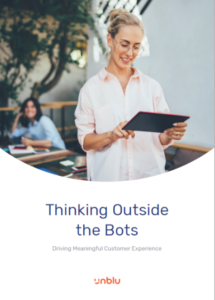The primary product that retail banks or financial centers can offer to their customers is mortgages. However, with recent shifts in customer behavior and a trend toward online banking, fewer customers are physically coming into branches.
Unlike simple banking transactional activities like transferring funds or checking their balances, taking out a mortgage is a significant decision. While customers do want the convenience of online banking, they also need to be sure that they are confident enough to carry out the entire process without speaking face-to-face with an advisor.
For financial providers, being able to offer a seamless digital customer journey for mortgages is essential to stand out competitively. But achieving this is a fine art. Unlike the traditional in-person experience, the digital mortgage process can take place across channels and touchpoints.
This presents more opportunities for friction that can ultimately result in a negative mortgage customer experience. By taking the time to create a streamlined online process, financial institutions can provide a convenient and fast mortgage experience that prioritizes personalized conversation.
Mortgage application process: leveraging digital tools
The key to a successful mortgage customer experience from beginning to end lies in offering the convenience of technology without losing the personal touch necessary to ensure the customers’ needs are met. There are various tools that can help achieve this.
Using chatbots to qualify leads
Loan officers have to dedicate a significant amount of time to customers who are interested in taking out a mortgage. This makes their time valuable and dealing with individuals who are not ready to commit can be frustrating.
Chatbots, while unable to manage complex interactions, are great tools to qualify potential leads. Using the power of machine learning and artificial intelligence (AI), customers can answer a series of simple, low-stakes questions. Based on their responses, the loan officer can decide if it’s worth speaking with them personally and moving forward with the interaction.
Communicating in real time with Live Chat
When customers have a quick issue or want reassurance on a specific point, they often prefer using text messages, whether SMS, WhatsApp, or Facebook Messenger. Live Chat gives officers the option to communicate with them on the channel of their choice, without risk of security issues or compliance. These real-time interactions can make a substantial difference, making the sessions three times more productive and saving 50% on average in time and costs dedicated to support.
Turning to video calls for high-touch interactions
Sooner or later in the digital mortgage process, it’s likely that messages aren’t going to be enough. For more involved conversations that deal with complex issues, customers need the same quality user experience online as they have when visiting a branch in person.
Not only do video calls offer this, but they allow it to happen at the time that’s most convenient for the customer. When the messaging channels have served their purpose, it’s easy for mortgage professionals to switch to a video call to deal with the issue at the precise moment necessary.
Best of all, it increases satisfaction all round, with 90–95% of banking customers claiming that they’re satisfied with digital advice and 85-90% of employees preferring the freedom the tools offer.
Closing deals through collaboration
The quality of the help that customers receive will determine if they go with a particular provider and take out their mortgage. More than anything else, this means getting personalized help that is tailored to their situation.
While messaging and video calls are powerful tools, they fall short of the in-person experience when it comes to guiding their customers through sometimes difficult documentation. In these situations, Co-Browsing or screen sharing can be the difference between a positive service experience and a negative one.
Co-Browsing is safe and fully compliant, allowing the loan officer to share their screen or gain access to the customer’s – who can remove permissions at any point. This allows them to offer tailored support as they would in an in-person meeting and close deals with confidence, and achieve a 15-20% increase in conversions compared to traditional means.
What would a typical digital mortgage journey look like?
Step 1: Gaining the customer’s trust

For many, taking out a mortgage only happens once or twice in their lifetime. It’s an important decision that cannot be taken lightly, especially for first-time buyers. This means that establishing trust is essential to convince the customer that you are the provider worth choosing.
When it comes to trust, there’s no room for error. In many ways, by the time the customer first shows interest in applying for a mortgage, they should already have a baseline level of trust in you. After all, you have likely been their account provider for years and the quality of the interactions they’ve had with you is important.
The fact of the matter is that trust is built over time, long before the customer decides to take the leap and apply for a mortgage. By offering an excellent service experience to all customers, you create the necessary foundation of trust for larger purchases like mortgages to take place.
Step 2: Being available when it matters most

While trust is built over time, the moment when they show interest in taking out a mortgage is a key point in the relationship. When making the decision, the demands the customer will have on your service infrastructure will generally be greater, given the importance of the situation.
Instead of mainly self-service options and a few simple questions, customers considering a digital mortgage will need flexible communication options across channels. For mortgage lenders or loan officers, it is important to be there at the precise moment in the customer journey when they’ve decided to take the leap.
The only way this is possible is by providing an omnichannel digital service that’s optimized across all devices and channels. With all interactions recorded in one place, advisors are better able to identify and capitalize on the moment of truth to provide personalized value exactly when it matters.
The second a customer is ready to talk, the advisor will receive a chat request in the queue or a notification on their mobile device, allowing them to join the conversation and engage with the prospect on their terms.
Step 3: Facilitating a speedy, seamless process
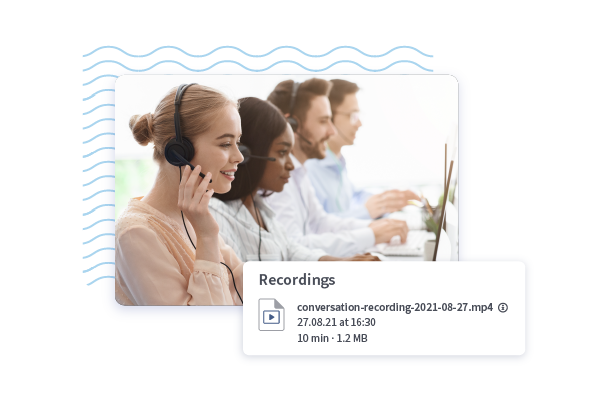
There’s always going to be a certain amount of time involved in closing a mortgage deal. From start to finish it can take days, weeks, or even months, with multiple interactions occurring at different points of this journey.
If a customer makes first contact and then goes cold for a week, it’s a waste of everyone’s time to begin the conversation again from scratch. To solve this issue, every interaction that the customer has with the bank should be kept in one, easily referenceable location to cut down on unnecessary repetition.
This is a significant part of what it means to be omnichannel. Beyond being available on every channel, the conversations that take place on each need to transfer seamlessly from one to the other.
For example, Unblu achieves this by securely saving all conversation history and financial information, as well as Co-Browsing sessions, calls, and any other interaction. When an advisor gets in contact with a potential customer, they can quickly and easily see all the back and forth that has taken place – even if it was with one of their colleagues.
The result is that the customers don’t have to resend loan documentation or explain their situation multiple times, and can continue the process exactly where they left off.
Step 4: Video meetings to provide reassurance
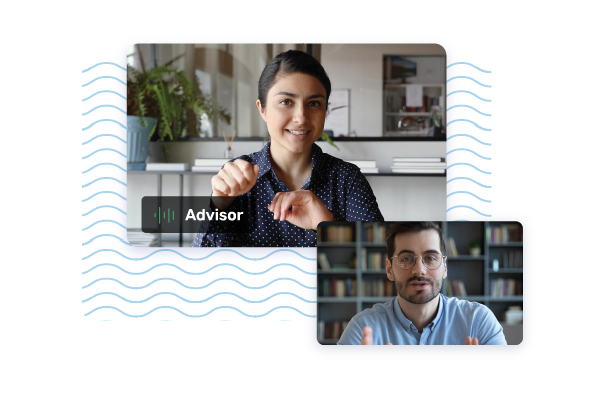
Traditional in-branch experiences are characterized by personal, face-to-face interactions. But this is no longer limited to these scenarios. Leaps forward in the quality of video calls means that customers can now benefit from remote interactions that have the same level of personalization as their in-person counterparts.
What’s more, video calls can actually offer added perks that aren’t possible with branches, namely that the customer doesn’t need to leave their home. Whenever an issue arises that customers want to address, they can do so at their own convenience and resolve it almost instantly.
Video calls can either be arranged beforehand or be entirely impromptu. For example, it’s common for the mortgage professional and the prospective customer to communicate via text. Then, with software like Unblu, once both parties decide to escalate the conversation, the loan officer can offer the prospect a video call.
The prospect will see this call within the same chat – so they don’t need to switch apps or download any other programs. And if the mortgage buyer doesn’t want to appear on video, they can choose an audio call or whatever makes them most comfortable.
Step 5: Provide a full in-person experience, remotely
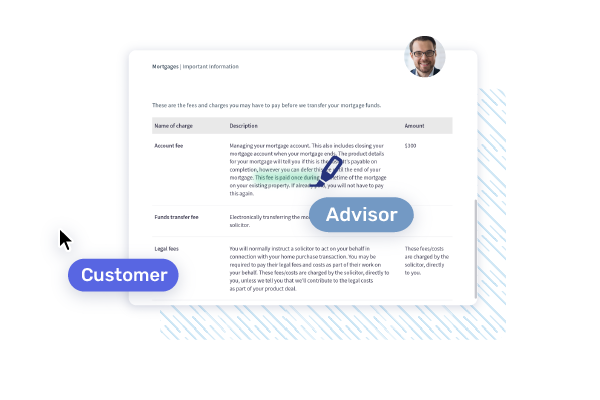
When on a video chat, the conversation may turn to documentation or specific web pages that need to be reviewed together. In these situations, the embedded Co-Browsing option allows advisors to collaborate in a safe, flexible manner to guide the prospect along in their journey.
The loan officer can use the mark and highlight tool to point out specific details – whether loan terms, areas for cost savings, or specific details regarding their credit history – and ensure that the customer is always up to speed on what’s happening.
Step 6: Removing friction at important moments

Once the customer has made their decision to purchase a mortgage deal, it’s in retail banks’ best interest to provide as seamless a journey to conversion as possible. However, certain documents inevitably need to be provided to complete the process.
For example, the loan applicant will be required to provide bank statements and payslips for their risk profile evaluation and credit checks, which can be time-consuming and frustrating if any delays or repetitions arise.
This is why Unblu has a specific document repository to ensure that the conversation can be picked up exactly where it was left off, without the need to send the same papers again. If one loan officer needs to pass the task over to another, the new agent can pick it up as easily as if they were there from the beginning.
Finally, when it comes time to fill out the final mortgage proposal form, the loan officer can guide the applicant using document Co-Browsing. They can dick boxes, alter text, co-edit, and even request a secure e-signature to close the deal as conveniently as possible.
Step 7: Keeping the conversation going
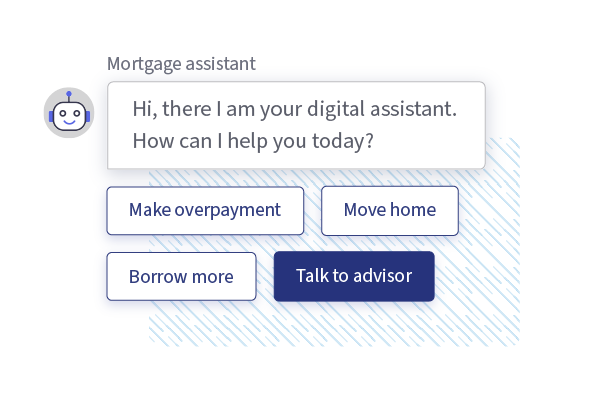
The hard work is over once the mortgage contract has been signed, but there will still need to be some interaction between the customer and the bank moving forward. Often, the queries that customers will have at this point will be much less complex, and the bots or artificial intelligence services are perfect tools at this point.
Of course, at any time, the customer can escalate the situation and get in contact with a service agent – ensuring the entire process is simple, streamlined, and positive.
Digital Advice & Unblu
The mortgage industry needs to innovate to keep up with customer demand and providing a streamlined digital experience is the only way to achieve this. A mortgage lending process that is outdated or full of roadblocks is going to cause customers to look elsewhere for a mortgage provider that they trust.
The mortgage market is still alive and well and remains one of traditional banks’ main product offerings. But the competition is steep. By using Unblu’s conversational banking tools, loan officers are able to connect with customers in a personal, efficient, and flexible way to ensure the homebuying journey is as simple as possible. In this way, they can outshine their competitors and boost customer confidence in their institution.
Want to learn more about Unblu? Booking a demo today.


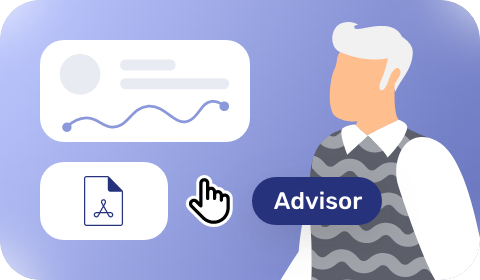
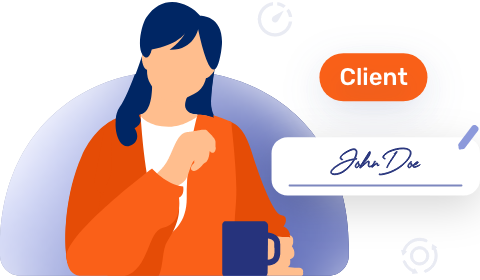
 Interaction Management Hub
Interaction Management Hub Secure Messenger
Secure Messenger Video & Voice
Video & Voice
